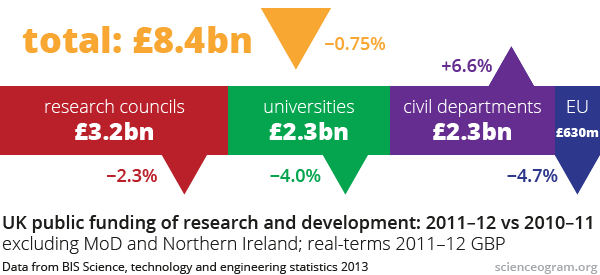SET statistics: departmental cuts masked by budgeting
Every September, the UK government provides a retrospective insight into research funding by releasing the Science, Engineering and Technology statistics. We’ve taken a look at the brand new 2013 release and, while the most recent data (for financial year 2011–12) show science spending falling in real terms, it’s unclear where the axe fell, and how hard.

As is often the case, the devil lies in the detail; this year the details include something of a scandal, in the form of astonishing reductions in certain departmental research budgets. Ferreting this out also provides an excellent example of how not to meaningfully report governmental spending.
First, the scandal: the Department for Education, the Department for Communities and Local Government, and the Home Office counted together slashed their research spending by over 50% in a single financial year.
The Department for Education, for example, oversaw a reduction in research funding from £28m in 2010–11 to £13m in 2011–12. The rationale for these cuts is summed up in the SET Statistics by a dry footnote: ‘In 2011–12, expenditure fell due a to move to drive down spend across all budgets, and reflects Ministerial priorities.’ Departmental research provides evidence to underpin the policies on which they spent their budgets, so this kind of rapid reduction in spend will be disturbing reading for advocates of evidence-based policy.
This scandal is well hidden, however. Total spending on R&D by government departments has actually increased by nearly 10%, which sounds like great news—but, since total public funding of R&D is dropping, this money must come from somewhere. In fact, the two significant increases in departmental R&D spending come from a £200m boost to the Department for Business, Innovation and Skills (BIS)—which inherited a number of projects previously managed by other departments—and a change in how Northern Ireland reports its spending, resulting in a further £60m increase (some 290%!) to their nominal departmental research spending.
Taken together, these increases more than mask the fact that the dramatic reduction in R&D performed by many government departments. We asked BIS for further information to clarify the impact of these budgetary reallocations, but were told that this wasn’t possible at present.
As we highlighted in our open letter to the Cabinet Office about the GIST spending data tool, splitting up data by what are effectively arcane internal accounting categories doesn’t allow for easy interpretation. In this case, what has actually happened to public funding of research is obfuscated by the movement of budgets between departments.
So, whilst R&D experienced real-terms cuts since the last election, government statistics don’t provide the level of detail necessary to make politicians and government departments truly accountable.